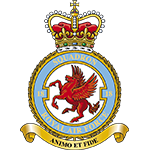RAF No 242 (Canadian) SquadronNo 242 (Canadian) Squadron
Motto: Toujour Pret (Always ready)
Formed on 15 August 1918 from No's 408, 409 and 514 Flights at Newhaven, equipped with Short 184 seaplanes, disbanding on 15 May 1919
Reformed on 30 October 1939 at Church Fenton as fighter unit composed of mainly Canadian personnel it was issued with Blenheims, which were exchanged for Hurricanes in January 1940. From its base at Church Fenton, it operated a detachment in France from 16 May but on the 20th, the squadron moved to Biggin Hill 16 June when its detachment it was evacuated. Severely depleted by the actions in France it was withdrawn to Coltishall to rest and recuperate and it was here that it received a new CO, Squadron Leader Douglas Bader.
Re-equipped and recovered it entered the Battle of Britain remaining at Coltishall throughout, although it often operated from advanced bases such as Duxford. It eventually moved to Duxford in October but a month later was back at Coltishall. From December it began fighter sweeps and bomber escort mission over France and these were maintained throughout 1941. In October it was withdrawn from operations and began preparations for deployment overseas, in this case the Far East.
Arriving in Singapore in January 1942, it was too late to stop the Japanese advance and it was soon withdrawn to Sumatra and later Java, but as casualties increased and spares diminished the squadron began to get dispersed and by the end of February 1942, it had practically ceased to exist. A new 242 Squadron formed at Turnhouse on 10 April with Spitfires, which were flown on defensive patrols initially in Scotland and then the North of England until August when it moved south to North Weald. However, by October it was again earmarked for overseas, leaving for North Africa in November, where it operated in support of the 1st Army's advance to Tunisia.
With the end of operations in North Africa, the squadron over to Malta in June 1943, where it supported the Allied landing in Sicily then moved onto that island to support the invasion of Italy. In September it transferred to the Italian mainland until April 1944 when it moved to Corsica in preparation for the forthcoming invasion of southern France. However, following the invasion, the squadron only remained on French soil for a month and in September it disposed of its aircraft to other units and the personnel returned to Naples in Italy, where it disbanded on 4 November 1944.
The squadron reformed on 15 November 1944 as a transport unit at Stoney Cross, equipped with Wellington XVIs for training, its operational equipment arriving in February 1945 in the form of Stirling Vs. These were used to fly freight to the Middle East and then onto the Far East. Some Yorks arrived in April and these were used to carry passengers as well as freight but then in July the Yorks left and the Stirling Vs were replaced by Stirling IVs which needed modifying before being of any use. However, in December the squadron moved to Merryfield and reverted to Yorks, which now employed on flights to India and the Azores. In 1948, the squadron joined the Berlin Airlift, after which it converted to the Hastings in June 1949 and reverted to its Far East routes until 1 May 1950, when it disbanded at Lyneham. It reformed once again on 1 October 1959 as a Bloodhound I Surface-to-Air-Missile unit at Marham, but disbanded on 30 September 1964, with the withdrawal of the Bloodhound I system.
Squadron Codes used: -
YD Allocated Apr 1939 - Sep 1939
LE Feb 1940 - Dec 1941, Apr 1942 - Nov 1944
KY Nov 1944 - 1948

 Editor for Asisbiz: Matthew Laird Acred
Editor for Asisbiz: Matthew Laird Acred
If you love our website please subscribe to our YouTube video channel
Please donate so we can make this site even better !!

